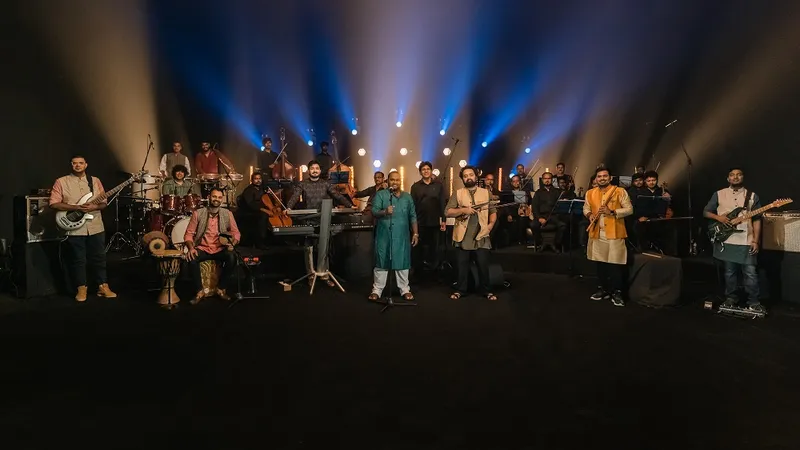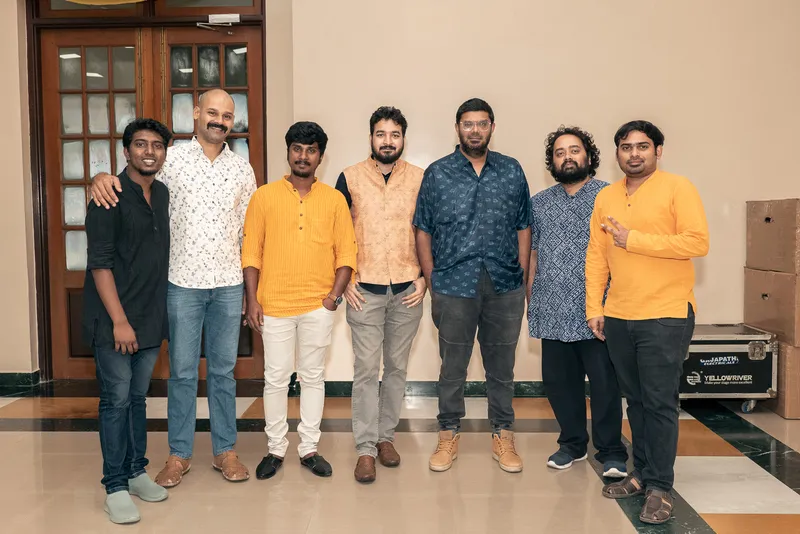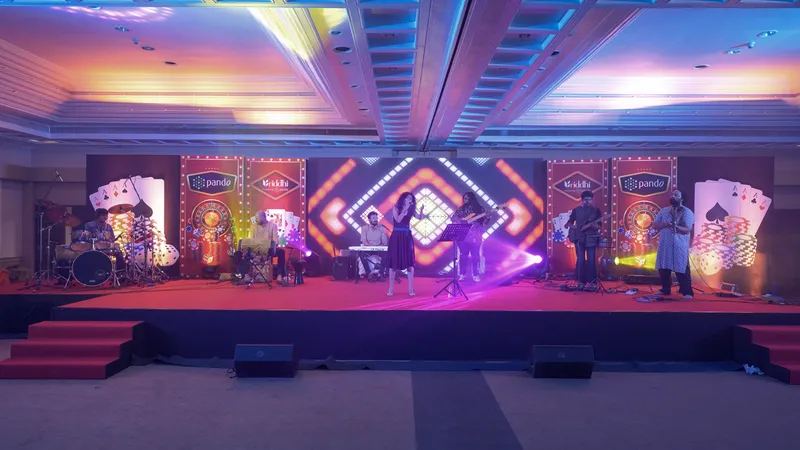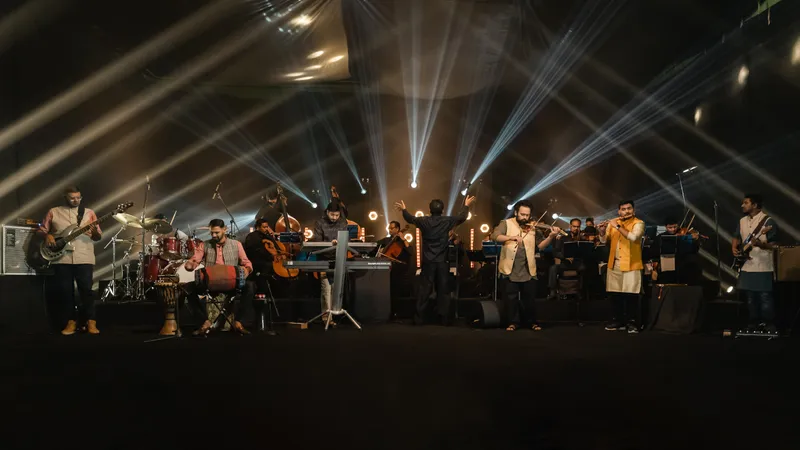Indie music band Oxygen thrives on the strength of collective effort
Chennai-based instrumental music band Oxygen, which turned 20 earlier this year, believes strongly in bonding and sharing a sense of togetherness. The band wants to bring back the culture of live concerts and musical conversations between artists.
It is hard to describe Oxygen’s music in a word. It doesn’t fall under one particular genre, and that's how the Chennai-based instrumental music band prefers it to be.
If one had to really put a name to their music, it could be termed “world music”, says Vijay Ganesan, the newest member of the band. And Metagen, the band’s latest release, is a perfect embodiment of that.
The album is a well-brewed potpourri of six grand compositions inspired by musical genres from around the world.
If you think the piece Saraswathi is a purely Carnatic composition based on the raga of the same name, wait till you hear the symphonic classical strains in the middle. Then there's Northern Lights, a James Bond-esque score with Indian nuances. For this composition, Oxygen collaborated with Stèphane Montigny, a trombone player from France.

Taking the Oriental route is Yin Yang that uses Chinese woodwind instrument dizi and reed instrument Bawu. Thandanaane is based on South Indian folk music while Uthal Puthal is a Bihu-style folk number with a Western classical influence.
5th Dimension, the last piece in the album, is a crazy, new-age experimental feast, with a tala cycle in five beats. “The coincidence was, when we first played this song, it ended exactly at 5 minutes 55 seconds,” chimes in C Girinandh, Founder of Oxygen.
The band collaborated with Tenor Strings, a 20-piece string orchestra, for the Metagen project, which marks Oxygen’s 20th anniversary.
(At the time of publication of this piece, Oxygen had released three of the six compositions.)
Twenty years and counting
The band, founded on the basis of friendship and strengthened by bonds formed along the way, has traversed a long journey of two decades.
Although some of the original members are no longer with the band, the philosophy of Oxygen is intact—the sense of togetherness that members feel and the emphasis on collective effort.
This is why Oxygen has never promoted one musician as its face. Everyone plays their part as one cohesive unit, which has helped the band sustain itself over the years, says Girinandh, who staunchly believes the word ‘band’ stands for ‘bond’.
It all began when a bunch of boys started a school band to play in ‘culturals’, at a time when ‘band culture’ was new and film music was the mainstay.
“Back then, we didn’t have an entertainment medium. So, we used to jam regularly. This deeply instilled in us a sense of togetherness,” says Girinandh who teamed up with his neighbour KS Ramana to start Oxygen.
Today, Oxygen is a seven-member team belting out original music with panache. While Girinandh composes, arranges, and plays the keys, Ramana plays percussion and composes. Lalit Talluri is the flautist, while Vijay plays the lead guitar. Carl Fernandes (bass guitar), Bharath Gopal (drums) and Akshay Ganesh (violin) form the rest of the band.

The members of Oxygen: (L to R) Vijay Ganesan, KS Ramana, Bharath Gopal, C Girinandh, Carl Fernandes, Akshay Ganesh and Lalit Talluri
Oxygen works with different musical genres such as Carnatic, jazz, punk, Western classical and folk music to create fascinating sounds. The band has 40 tracks and 3,000 live concerts under its belt. Its albums include Breath of Music, Dimensions, Aura, and Metagen.
Technology in music
In its 20-year journey, Oxygen has seen the world of music undergo a sea of transformations. One of the most important developments is the emergence of technology.
“With new-age technology, we are able to feed our ideas on the go and execute the sounds we have in our mind,” says Girinandh.
Metagen incorporates spectral and sonic capabilities and aesthetic lighting to give listeners an immersive experience. The album was mixed and mastered using Dolby Atmos and Spatial Audio technologies for pristine clarity and superior definition.
According to Lalit, these technologies make listeners a part of the experience. “You feel the concert is happening in front of you, when you close your eyes.”
Essence of music
How does Oxygen ensure musical aesthetics are not compromised while incorporating technology?
“Whatever the technology is, the most important piece is the actual composition. Without this, any amount of technology will not make any sense,” responds Ramana.
Hence, Oxygen’s compositions are created the good old-fashioned way—jamming songs and planning out the various parts. “Only our output is displayed through technology; there is no change in the core process,” says the percussionist.
Comparing the music of then and now, Girinandh says the soul of music is missing today as artists are not sharing musical conversations with each other. “We have adapted to a workflow where artists are called in separately and their music is recorded. There is no conversation between artists. That’s why we perform and jam together. We generate ideas during our performances. We want to bring back the soul of music through conversations.”
Live concert culture
The band also wants to bring back the culture of live concerts, something that’s taken a backseat in recent times.
Lalit says, “If something is not interesting, listeners scroll to the next. They would rather listen to the YouTube link of the concert than watch it live.”
However, Ramana feels it’s possible to revive the aura of live concerts. “Earlier people used to sit through a two-hour concert and enjoy it. Now their attention span has reduced to a large extent. But if you can attract within 30 seconds, there is still an audience who will come and listen to a live concert.”
Vijay feels live concerts won’t go away as “nothing can equal the experience one gets in a concert hall”. He refers to the band’s common influence, Snarky Puppy, an American instrumental ensemble, known to promote live music.

Oxygen band, with singer Maalavika Sundar, during a show in Chennai
Original content
What will draw audiences to a live concert, even in the era of Reels and Shorts, is original content, believes the band.
“People connect to original music,” insists Girinandh, and this is what Oxygen wants to give people. “Instrumental music is not bound by language and works well in a congregation of people of all ages.”
Girinandh wishes to see more indie bands emerging, with faith in original music. “Film covers are fine but we need original music. There are a lot of passionate musicians. But I want to see band culture. More musicians should develop their musicality.”

Oxygen band during a live recording in Chennai
Exploring with an open mind
Oxygen develops its musicality by going with the flow and exploring various sounds instinctively. This exploratory nature also works well when they collaborate with other artists.
The band has worked with artists such as AR Rahman, Carnatic vocalist Aruna Sairam, singer Shankar Mahadevan, and flautist Rasika Shekar. “We like to collaborate with artists who have an open mind and not have boundaries on what will work or not,” says Girinandh.
The members of the band like to keep an open mind that’s devoid of clutter. “Nowadays Ramana and I don’t even listen to songs. So, we don’t have a validation point,” says Girinandh.
Ramana illustrates this further, “Whenever an idea pops up, it is new for us. We are in the awe moment. We don’t have a point X so that we come to point Y.”
This ability to explore sounds with an inquisitive, eager mind and not seek validation at every point is what keeps Oxygen going.
Edited by Teja Lele







